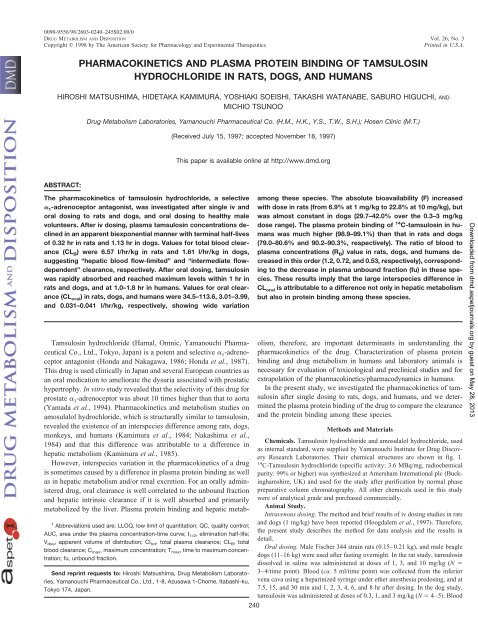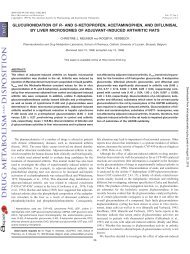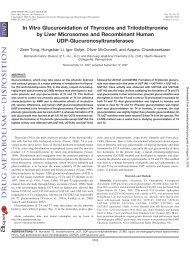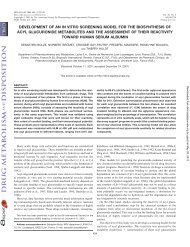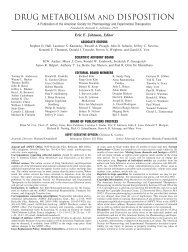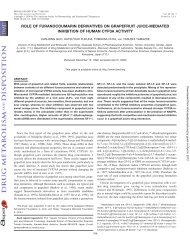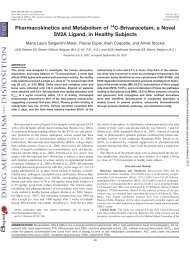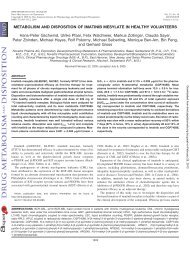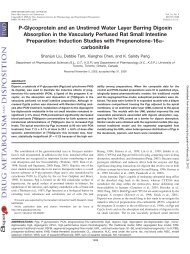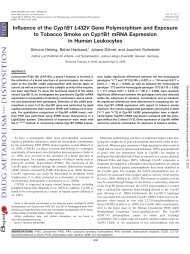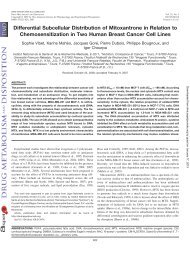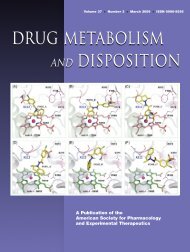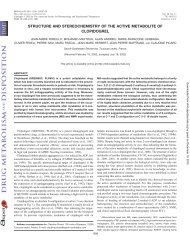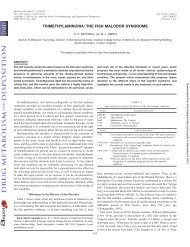pharmacokinetics and plasma protein binding of tamsulosin - Drug ...
pharmacokinetics and plasma protein binding of tamsulosin - Drug ...
pharmacokinetics and plasma protein binding of tamsulosin - Drug ...
Create successful ePaper yourself
Turn your PDF publications into a flip-book with our unique Google optimized e-Paper software.
0090-9556/98/2603-0240–245$02.00/0<br />
DRUG METABOLISM AND DISPOSITION Vol. 26, No. 3<br />
Copyright © 1998 by The American Society for Pharmacology <strong>and</strong> Experimental Therapeutics Printed in U.S.A.<br />
PHARMACOKINETICS AND PLASMA PROTEIN BINDING OF TAMSULOSIN<br />
HYDROCHLORIDE IN RATS, DOGS, AND HUMANS<br />
HIROSHI MATSUSHIMA, HIDETAKA KAMIMURA, YOSHIAKI SOEISHI, TAKASHI WATANABE, SABURO HIGUCHI, AND<br />
MICHIO TSUNOO<br />
ABSTRACT:<br />
<strong>Drug</strong> Metabolism Laboratories, Yamanouchi Pharmaceutical Co. (H.M., H.K., Y.S., T.W., S.H.); Hosen Clinic (M.T.)<br />
The <strong>pharmacokinetics</strong> <strong>of</strong> <strong>tamsulosin</strong> hydrochloride, a selective<br />
1-adrenoceptor antagonist, was investigated after single iv <strong>and</strong><br />
oral dosing to rats <strong>and</strong> dogs, <strong>and</strong> oral dosing to healthy male<br />
volunteers. After iv dosing, <strong>plasma</strong> <strong>tamsulosin</strong> concentrations declined<br />
in an apparent biexponential manner with terminal half-lives<br />
<strong>of</strong> 0.32 hr in rats <strong>and</strong> 1.13 hr in dogs. Values for total blood clearance<br />
(CL B) were 6.57 l/hr/kg in rats <strong>and</strong> 1.61 l/hr/kg in dogs,<br />
suggesting “hepatic blood flow-limited” <strong>and</strong> “intermediate flowdependent”<br />
clearance, respectively. After oral dosing, <strong>tamsulosin</strong><br />
was rapidly absorbed <strong>and</strong> reached maximum levels within 1 hr in<br />
rats <strong>and</strong> dogs, <strong>and</strong> at 1.0–1.8 hr in humans. Values for oral clearance<br />
(CL oral) in rats, dogs, <strong>and</strong> humans were 34.5–113.6, 3.01–3.99,<br />
<strong>and</strong> 0.031–0.041 l/hr/kg, respectively, showing wide variation<br />
Tamsulosin hydrochloride (Harnal, Omnic, Yamanouchi Pharmaceutical<br />
Co., Ltd., Tokyo, Japan) is a potent <strong>and</strong> selective 1-adrenoceptor<br />
antagonist (Honda <strong>and</strong> Nakagawa, 1986; Honda et al., 1987).<br />
This drug is used clinically in Japan <strong>and</strong> several European countries as<br />
an oral medication to ameliorate the dysuria associated with prostatic<br />
hypertrophy. In vitro study revealed that the selectivity <strong>of</strong> this drug for<br />
prostate 1-adrenoceptor was about 10 times higher than that to aorta<br />
(Yamada et al., 1994). Pharmacokinetics <strong>and</strong> metabolism studies on<br />
amosulalol hydrochloride, which is structurally similar to <strong>tamsulosin</strong>,<br />
revealed the existence <strong>of</strong> an interspecies difference among rats, dogs,<br />
monkeys, <strong>and</strong> humans (Kamimura et al., 1984; Nakashima et al.,<br />
1984) <strong>and</strong> that this difference was attributable to a difference in<br />
hepatic metabolism (Kamimura et al., 1985).<br />
However, interspecies variation in the <strong>pharmacokinetics</strong> <strong>of</strong> a drug<br />
is sometimes caused by a difference in <strong>plasma</strong> <strong>protein</strong> <strong>binding</strong> as well<br />
as in hepatic metabolism <strong>and</strong>/or renal excretion. For an orally administered<br />
drug, oral clearance is well correlated to the unbound fraction<br />
<strong>and</strong> hepatic intrinsic clearance if it is well absorbed <strong>and</strong> primarily<br />
metabolized by the liver. Plasma <strong>protein</strong> <strong>binding</strong> <strong>and</strong> hepatic metab-<br />
(Received July 15, 1997; accepted November 18, 1997)<br />
This paper is available online at http://www.dmd.org<br />
among these species. The absolute bioavailability (F) increased<br />
with dose in rats (from 6.9% at 1 mg/kg to 22.8% at 10 mg/kg), but<br />
was almost constant in dogs (29.7–42.0% over the 0.3–3 mg/kg<br />
dose range). The <strong>plasma</strong> <strong>protein</strong> <strong>binding</strong> <strong>of</strong> 14 C-<strong>tamsulosin</strong> in humans<br />
was much higher (98.9–99.1%) than that in rats <strong>and</strong> dogs<br />
(79.0–80.6% <strong>and</strong> 90.2–90.3%, respectively). The ratio <strong>of</strong> blood to<br />
<strong>plasma</strong> concentrations (R B) value in rats, dogs, <strong>and</strong> humans decreased<br />
in this order (1.2, 0.72, <strong>and</strong> 0.53, respectively), corresponding<br />
to the decrease in <strong>plasma</strong> unbound fraction (fu) in these species.<br />
These results imply that the large interspecies difference in<br />
CL oral is attributable to a difference not only in hepatic metabolism<br />
but also in <strong>protein</strong> <strong>binding</strong> among these species.<br />
olism, therefore, are important determinants in underst<strong>and</strong>ing the<br />
<strong>pharmacokinetics</strong> <strong>of</strong> the drug. Characterization <strong>of</strong> <strong>plasma</strong> <strong>protein</strong><br />
<strong>binding</strong> <strong>and</strong> drug metabolism in humans <strong>and</strong> laboratory animals is<br />
necessary for evaluation <strong>of</strong> toxicological <strong>and</strong> preclinical studies <strong>and</strong> for<br />
extrapolation <strong>of</strong> the <strong>pharmacokinetics</strong>/pharmacodynamics in humans.<br />
In the present study, we investigated the <strong>pharmacokinetics</strong> <strong>of</strong> <strong>tamsulosin</strong><br />
after single dosing to rats, dogs, <strong>and</strong> humans, <strong>and</strong> we determined<br />
the <strong>plasma</strong> <strong>protein</strong> <strong>binding</strong> <strong>of</strong> the drug to compare the clearance<br />
<strong>and</strong> the <strong>protein</strong> <strong>binding</strong> among these species.<br />
Methods <strong>and</strong> Materials<br />
Chemicals. Tamsulosin hydrochloride <strong>and</strong> amosulalol hydrochloride, used<br />
as internal st<strong>and</strong>ard, were supplied by Yamanouchi Institute for <strong>Drug</strong> Discovery<br />
Research Laboratories. Their chemical structures are shown in fig. 1.<br />
14<br />
C-Tamsulosin hydrochloride (specific activity: 3.6 MBq/mg, radiochemical<br />
purity: 99% or higher) was synthesized at Amersham International plc (Buckinghamshire,<br />
UK) <strong>and</strong> used for the study after purification by normal phase<br />
preparative column chromatography. All other chemicals used in this study<br />
were <strong>of</strong> analytical grade <strong>and</strong> purchased commercially.<br />
Animal Study.<br />
Intravenous dosing. The method <strong>and</strong> brief results <strong>of</strong> iv dosing studies in rats<br />
1 <strong>and</strong> dogs (1 mg/kg) have been reported (Hoogdalem et al., 1997). Therefore,<br />
Abbreviations used are: LLOQ, low limit <strong>of</strong> quantitation; QC, quality control;<br />
the present study describes the method for data analysis <strong>and</strong> the results in<br />
AUC, area under the <strong>plasma</strong> concentration-time curve; t1/2, elimination half-life;<br />
detail.<br />
Vdss, apparent volume <strong>of</strong> distribution; Cltot, total <strong>plasma</strong> clearance; CLB, total<br />
Oral dosing. Male Fischer 344 strain rats (0.15–0.21 kg), <strong>and</strong> male beagle<br />
blood clearance; Cmax, maximum concentration; Tmax, time to maximum concen-<br />
dogs (11–16 kg) were used after fasting overnight. In the rat study, <strong>tamsulosin</strong><br />
tration; fu, unbound fraction.<br />
dissolved in saline was administered at doses <strong>of</strong> 1, 3, <strong>and</strong> 10 mg/kg (N <br />
Send reprint requests to: Hiroshi Matsushima, <strong>Drug</strong> Metabolism Laborato- 3–4/time point). Blood (ca. 5 ml/time point) was collected from the inferior<br />
ries, Yamanouchi Pharmaceutical Co., Ltd., 1-8, Azusawa 1-Chome, Itabashi-ku, vena cava using a heparinized syringe under ether anesthesia predosing, <strong>and</strong> at<br />
Tokyo 174, Japan.<br />
7.5, 15, <strong>and</strong> 30 min <strong>and</strong> 1, 2, 3, 4, 6, <strong>and</strong> 8 hr after dosing. In the dog study,<br />
<strong>tamsulosin</strong> was administered at doses <strong>of</strong> 0.3, 1, <strong>and</strong> 3 mg/kg (N 4–5). Blood<br />
240<br />
Downloaded from<br />
dmd.aspetjournals.org by guest on May 28, 2013
FIG. 1.Chemical structure <strong>of</strong> <strong>tamsulosin</strong> (a) <strong>and</strong> amosulalol (b).<br />
(ca. 5 ml/time point) was collected from the forelimb vein predosing, <strong>and</strong> at<br />
7.5, 15, <strong>and</strong> 30 min <strong>and</strong> 1, 2, 3, 4, 6, 8, <strong>and</strong> 10 hr after dosing. The same dogs<br />
were used in the iv <strong>and</strong> oral dosing studies except for the 3-mg/kg oral dosing<br />
study, following a washout period <strong>of</strong> at least 1 week. The 3-mg/kg oral dosing<br />
study was conducted on five different dogs. Plasma was separated by centrifugation<br />
at 1000g for 15 min <strong>and</strong> stored at 20°C until analysis. Dose levels in<br />
these animal studies were selected to measure the <strong>plasma</strong> <strong>tamsulosin</strong> concentrations<br />
with sufficient sensitivity.<br />
Clinical Study. Eight Japanese healthy male volunteers (20–24 yr old,<br />
52–74 kg, 161.2–181 cm) were enrolled in the study. Subjects were divided<br />
into groups A <strong>and</strong> B with four subjects in each group. Group A was orally<br />
dosed with <strong>tamsulosin</strong> in a capsule form (lactose-triturated powder) at a dose<br />
<strong>of</strong> 0.2 mg <strong>and</strong> group B at doses <strong>of</strong> 0.05 <strong>and</strong> 0.1 mg. Blood was collected from<br />
the antecubital vein using a heparinized syringe predosing, <strong>and</strong> at 0.5, 1, 2, 3,<br />
4, 6, 8, 12, 15, <strong>and</strong> 24 hr after dosing. After centrifugation, <strong>plasma</strong> was<br />
separated <strong>and</strong> stored at 20°C until analysis.<br />
Sample Analysis. An aliquot <strong>of</strong> <strong>plasma</strong> (1.5 ml) was buffered with 1 ml <strong>of</strong><br />
saturated sodium bicarbonate solution <strong>and</strong> extracted with 5 ml <strong>of</strong> ethyl acetate<br />
after addition <strong>of</strong> 100 l <strong>of</strong> internal st<strong>and</strong>ard aqueous solution (250 ng <strong>of</strong><br />
amosulalol). The extract was removed <strong>and</strong> then 2.5 ml <strong>of</strong> 0.4N HCl was added.<br />
The mixture was shaken, centrifuged, <strong>and</strong> the organic layer was discarded. The<br />
water layer was buffered with 2 ml <strong>of</strong> saturated sodium bicarbonate solution<br />
<strong>and</strong> extracted again with 5 ml <strong>of</strong> ethyl acetate. The extract was removed <strong>and</strong><br />
evaporated to dryness under reduced pressure. The residue was dissolved in 50<br />
l <strong>of</strong> 0.1 M NaHCO 3, <strong>and</strong> 500 g <strong>of</strong> dansylchloride dissolved in acetone (100<br />
l) was added. Reaction was performed for 90 min at 35°C. After addition <strong>of</strong><br />
5 ml <strong>of</strong> distilled water, the reaction mixture was extracted with 5 ml <strong>of</strong> diethyl<br />
ether. The extract was removed <strong>and</strong> evaporated to dryness in a water bath at<br />
45°C. The residue was reconstituted in 60 l <strong>of</strong> the mobile phase (benzene/<br />
methanol 100:1 v/v), <strong>and</strong> a small aliquot (20–50 l) <strong>of</strong> the sample was injected<br />
onto the HPLC system. Tamsulosin <strong>and</strong> amosulalol, which were dansylated,<br />
were detected after elution from a normal phase column (Nucleosil SI100-5,<br />
250 mm 4 mm i.d., Chemco, Osaka, Japan) by use <strong>of</strong> a fluorescence detector<br />
(RF-535, Shimadzu, Kyoto, Japan) with excitation at 352 nm <strong>and</strong> emission at<br />
500 nm. The low limit <strong>of</strong> quantitation (LLOQ) 1 was 0.5 ng/ml for human<br />
<strong>plasma</strong> <strong>and</strong> 1.0 ng/ml for rat <strong>and</strong> dog <strong>plasma</strong>. The intra <strong>and</strong> interday precision<br />
expressed as coefficient <strong>of</strong> variance for LLOQ <strong>and</strong> each quality control (QC)<br />
concentration (3, 250, <strong>and</strong> 400 ng/ml for rats <strong>and</strong> dogs <strong>and</strong> 1.5, 40, <strong>and</strong> 60<br />
ng/ml for humans) was within 13.41% for rat <strong>plasma</strong>, within 8.7% for dog<br />
<strong>plasma</strong>, <strong>and</strong> within 13.88% for human <strong>plasma</strong>. The intra <strong>and</strong> interday accuracy<br />
expressed as relative error for the LLOQ <strong>and</strong> QC concentration was within<br />
13.35% for rat <strong>plasma</strong>, within 7.36% for dog <strong>plasma</strong>, <strong>and</strong> within 13.83% for<br />
human <strong>plasma</strong>. Tamsulosin could be quantified over the range 1–500 ng/ml in<br />
rat <strong>and</strong> dog <strong>plasma</strong> <strong>and</strong> 0.5–80 ng/ml in human <strong>plasma</strong>.<br />
Determination <strong>of</strong> the Ratio <strong>of</strong> Blood to Plasma Concentrations (R B).<br />
Heparinized blood <strong>of</strong> rats, dogs, <strong>and</strong> humans was used. To 2.95-ml aliquots <strong>of</strong><br />
blood, 0.05-ml aliquots <strong>of</strong> phosphate buffered isotonic solution (pH 7.4)<br />
containing 14 C-<strong>tamsulosin</strong> were added to make concentrations <strong>of</strong> 50 ng/ml in<br />
rat <strong>and</strong> dog blood <strong>and</strong> 200 ng/ml in human blood (N 3 for each species).<br />
After incubation for 30 min at 37°C, a 0.05-ml aliquot was taken from each<br />
PHARMACOKINETICS OF TAMSULOSIN<br />
blood sample to measure the blood concentration, <strong>and</strong> the remaining sample<br />
was centrifuged for 15 min at 1000g. After centrifugation, a 0.05-ml aliquot <strong>of</strong><br />
<strong>plasma</strong> was taken to measure the <strong>plasma</strong> concentration. This 0.05-ml aliquot <strong>of</strong><br />
<strong>plasma</strong> was diluted to 1 ml with distilled water, <strong>and</strong> 10 ml <strong>of</strong> liquid scintillator<br />
(Aquasol-2, New Engl<strong>and</strong> Nuclear, Boston, MA) was added. The 0.05-ml<br />
aliquot <strong>of</strong> blood was added to the mixture <strong>of</strong> 0.5 ml <strong>of</strong> tissue solubilizer<br />
(Solene 350, Packard Instrument, Meriden, CT) <strong>and</strong> 0.5 ml <strong>of</strong> isopropanol to<br />
solubilize red blood cells, <strong>and</strong> then 30% hydrogen peroxide solution was added<br />
for decolorization. After overnight incubation at 4°C, 10 ml <strong>of</strong> liquid scintillator<br />
(Hionic fluore, Packard) was added to this mixture. Samples were<br />
counted using a liquid scintillation counter (LS 6000TA, Beckman Instruments,<br />
Inc., Fullerton, CA), <strong>and</strong> R B values were determined comparing the<br />
concentration <strong>of</strong> 14 C-<strong>tamsulosin</strong> in blood <strong>and</strong> <strong>plasma</strong>.<br />
Protein Binding Study. To 2-ml aliquots <strong>of</strong> rat, dog, <strong>and</strong> human <strong>plasma</strong>,<br />
0.1-ml aliquots <strong>of</strong> phosphate buffered isotonic solution containing 14 C-<strong>tamsulosin</strong><br />
were added to make concentrations <strong>of</strong> 200 ng/ml <strong>and</strong> 600 ng/ml, except<br />
for human <strong>plasma</strong> at the concentration <strong>of</strong> 200 ng/ml which was prepared by<br />
adding 0.3-ml aliquots <strong>of</strong> 14 C-<strong>tamsulosin</strong> solution to 6-ml aliquots <strong>of</strong> <strong>plasma</strong><br />
(N 3 for each species). After incubation for 30 min at 37°C, a 0.2-ml aliquot<br />
was taken from each <strong>plasma</strong> sample to measure the total <strong>plasma</strong> concentration,<br />
<strong>and</strong> the unused portion was transferred to an ultrafiltration tube (Ultracent-10,<br />
Tosoh, Tokyo, Japan). Unused human <strong>plasma</strong> containing 200 ng/ml <strong>of</strong> 14 C<strong>tamsulosin</strong><br />
were divided into the three tubes. The tubes were centrifuged for 15<br />
min (1000g, 37°C), <strong>and</strong> a 0.2-ml aliquot <strong>of</strong> filtrate was taken for the measurement<br />
<strong>of</strong> unbound <strong>plasma</strong> concentration. The filtrates from the divided human<br />
<strong>plasma</strong> were pooled <strong>and</strong> a 0.6-ml aliquot was taken for measurement. The<br />
aliquots <strong>of</strong> <strong>plasma</strong> <strong>and</strong> filtrate were diluted to 1 ml with distilled water, <strong>and</strong> 10<br />
ml <strong>of</strong> liquid scintillator (Aquasol-2) was added. Samples were counted using<br />
a liquid scintillation counter (2000CA, Packard).<br />
Data Analysis. Plasma <strong>tamsulosin</strong> concentrations after iv dosing were fitted<br />
to a two-compartment model using the nonlinear least squares regression<br />
program NONLIN 84 (Statistical Consultants Co., Apex, NC) to calculate the<br />
following pharmacokinetic parameters: half-life (t 1/2), half-life (t 1/2),<br />
apparent volume <strong>of</strong> distribution (V dss), area under the <strong>plasma</strong> concentrationtime<br />
curve (AUC), <strong>and</strong> total <strong>plasma</strong> clearance (CL tot). The total blood clearance<br />
(CL B) was calculated as CL tot/R B. Plasma <strong>tamsulosin</strong> concentrations after<br />
oral dosing were subject to noncompartmental analysis. The maximum concentration<br />
(C max) <strong>and</strong> time to C max (T max) were observed values. The terminal<br />
elimination rate constant () was determined by least squares regression<br />
analysis <strong>of</strong> terminal log-linear portions <strong>of</strong> the <strong>plasma</strong> concentration-time<br />
pr<strong>of</strong>ile ( 2.303 slope). The elimination half-life (t 1/2) was calculated as<br />
0.693/. The AUC extrapolated to infinity (AUC 0–) was determined by the<br />
trapezoidal rule up to the last time point <strong>and</strong> thereafter extrapolated to infinity<br />
on the basis <strong>of</strong> . Pharmacokinetic parameters in rats were calculated using the<br />
mean <strong>plasma</strong> concentrations because they were sacrificed at their sampling<br />
time, whereas those in dogs <strong>and</strong> humans were calculated individually. The<br />
absolute bioavailability <strong>of</strong> <strong>tamsulosin</strong> after oral administration (F) was calculated<br />
from the ratio <strong>of</strong> AUC 0– after oral dosing to that after iv dosing,<br />
corrected for the difference in dose levels. Oral clearance (CL oral) was calculated<br />
as dose/AUC 0–. The percentage bound <strong>and</strong> the unbound fraction (fu)<br />
were calculated using the following equations:<br />
% bound C t C u/Ct 100<br />
fu C u/C t<br />
241<br />
where C t is the total 14 C-<strong>tamsulosin</strong> concentration <strong>and</strong> C u the unbound 14 C<strong>tamsulosin</strong><br />
concentration in <strong>plasma</strong>.<br />
Results<br />
Intravenous Dosing to Rats <strong>and</strong> Dogs. Plasma concentration-time<br />
pr<strong>of</strong>iles <strong>of</strong> <strong>tamsulosin</strong> in rats <strong>and</strong> dogs after iv dosing are shown in fig.<br />
2. The <strong>plasma</strong> concentrations declined in an apparent biexponential<br />
manner. The mean t1/2 in rats <strong>and</strong> dogs were 0.32 <strong>and</strong> 1.13 hr,<br />
respectively, indicating that <strong>tamsulosin</strong> was eliminated rapidly in rats<br />
in comparison with dogs. Vdss <strong>and</strong> CLtot in rats were 2.86 l/kg <strong>and</strong><br />
7.88 l/hr/kg, <strong>and</strong> those in dogs were 1.74 l/kg <strong>and</strong> 1.16 l/hr/kg,<br />
Downloaded from<br />
dmd.aspetjournals.org by guest on May 28, 2013
242 MATSUSHIMA ET AL.<br />
FIG. 2.Plasma concentration-time pr<strong>of</strong>iles <strong>of</strong> unchanged <strong>tamsulosin</strong> in rats <strong>and</strong><br />
dogs after intravenous dosing at a dose <strong>of</strong> 1 mg/kg. Each point represents the<br />
mean SD <strong>of</strong> three rats (■) or four dogs (F).<br />
respectively. V dss <strong>and</strong> CL tot in dogs were smaller than those in rats<br />
(table 1).<br />
Oral Dosing to Rats <strong>and</strong> Dogs. After oral dosing, <strong>plasma</strong> <strong>tamsulosin</strong><br />
concentrations rapidly increased <strong>and</strong> reached maximum levels at<br />
7.5 min in rats <strong>and</strong> 7.5–30 min in dogs (figs. 3 <strong>and</strong> 4, tables 2 <strong>and</strong> 3).<br />
The <strong>plasma</strong> concentrations decreased with t 1/2 <strong>of</strong> 0.99–1.15 hr in rats<br />
<strong>and</strong> 1.27–1.68 hr in dogs, showing no dose dependency. CL oral values<br />
were 34.5–113.6 l/hr/kg in rats <strong>and</strong> 3.01–3.99 l/hr/kg in dogs. Increase<br />
in C max <strong>and</strong> AUC 0– in rats was greater than proportional to doses<br />
over the 1–10 mg/kg dose range, whereas that in dogs was proportional<br />
to doses over the 0.3–3 mg/kg dose range. Thus, absolute<br />
bioavailability in rats increased with increases in dose from 6.9% at 1<br />
mg/kg to 22.8% at 10 mg/kg, whereas that in dogs was 29.7–42.0%,<br />
remaining constant within the dose range studied.<br />
Clinical Study. After oral dosing to healthy male volunteers,<br />
<strong>plasma</strong> <strong>tamsulosin</strong> concentrations increased <strong>and</strong> reached maximum<br />
levels at 1.0–1.8 hr after dosing <strong>and</strong> thereafter decreased gradually<br />
with t 1/2 <strong>of</strong> 5.25–6.79 hr, showing no dose dependency (fig. 5, table<br />
4). Elimination <strong>of</strong> <strong>tamsulosin</strong> in humans was slower than that in rats<br />
<strong>and</strong> dogs. CL oral values were 0.031–0.041 l/hr/kg (1.85–2.61 l/hr).<br />
Increase in C max <strong>and</strong> AUC 0– was proportional to the dose over the<br />
0.05–0.2 mg dose range. Moderate orthostatic hypotension was observed<br />
in two volunteers at a dose <strong>of</strong> 0.2 mg.<br />
Plasma Protein Binding <strong>and</strong> R B Values. The results <strong>of</strong> <strong>plasma</strong><br />
<strong>protein</strong> <strong>binding</strong> <strong>and</strong> R B values in rats, dogs, <strong>and</strong> humans are shown in<br />
table 5. Percentage bound <strong>of</strong> 14 C-<strong>tamsulosin</strong> in rats, dogs, <strong>and</strong> humans<br />
was 79.0–80.6%, 90.2–90.3% <strong>and</strong> 98.9–99.1%, respectively, indicating<br />
that <strong>tamsulosin</strong> was highly bound to human <strong>plasma</strong> <strong>protein</strong>.<br />
Protein <strong>binding</strong> was almost constant regardless <strong>of</strong> the increase in<br />
concentration from 200 to 600 ng/ml in all species. Fu in rats (0.194–<br />
0.210) <strong>and</strong> dogs (0.097–0.098) was 20 <strong>and</strong> 10 times higher than that<br />
in humans (0.009–0.011), respectively. R B values in rats, dogs, <strong>and</strong><br />
humans were 1.2, 0.72, <strong>and</strong> 0.53, respectively, appearing to decrease<br />
with increases in the <strong>plasma</strong> <strong>protein</strong> <strong>binding</strong> among these species.<br />
CL B values calculated using these R B values were 6.57 l/hr/kg in rats<br />
<strong>and</strong> 1.61 l/hr/kg in dogs (table 1). CL oral/fu values calculated to<br />
estimate the hepatic intrinsic clearance (CL hint) <strong>of</strong> <strong>tamsulosin</strong> were<br />
164–586 l/hr/kg in rats, 31–41 l/hr/kg in dogs, <strong>and</strong> 2.8–4.6 l/hr/kg in<br />
humans. Distribution volume based on unbound <strong>tamsulosin</strong> (V dss/fu)<br />
was 13.6–14.7 l/kg in rats <strong>and</strong> 17.6–17.9 l/kg in dogs (table 6).<br />
TABLE 1<br />
Pharmacokinetic parameters <strong>of</strong> <strong>tamsulosin</strong> after intravenous administration to<br />
rats <strong>and</strong> dogs at the dose <strong>of</strong> 1 mg/kg<br />
Parameter Rats (N 3) Dogs (N 4)<br />
t 1/2 (hr) 0.035 0.134 0.034<br />
t 1/2 (hr) 0.32 1.13 0.07<br />
AUC 0– (nghr/ml) 127 873 65<br />
V dss (l/kg) 2.86 1.74 0.16<br />
CL tot (l/hr/kg) 7.88 1.16 0.08<br />
CL B (l/hr/kg) 6.57 1.61<br />
Values represent the mean ( SEM).<br />
CL B CL tot/R B.<br />
FIG. 3.Plasma concentration-time pr<strong>of</strong>iles <strong>of</strong> unchanged <strong>tamsulosin</strong> in rats after<br />
oral dosing. Each point represents the mean SD <strong>of</strong> three (1 <strong>and</strong> 3 mg/kg) or<br />
four (10 mg/kg) rats. (■) 1 mg/kg; (F) 3 mg/kg; (Œ) 10 mg/kg.<br />
FIG. 4.Plasma concentration-time pr<strong>of</strong>iles <strong>of</strong> unchanged <strong>tamsulosin</strong> in dogs<br />
after oral dosing. Each point represents the mean SD <strong>of</strong> four (0.3 <strong>and</strong> 1 mg/<br />
kg) or five (3 mg/kg) dogs. (■) 0.3 mg/kg; (F) 1 mg/kg; (Œ) 3 mg/kg.<br />
Discussion<br />
After oral dosing <strong>of</strong> 14 C-<strong>tamsulosin</strong> at a dose <strong>of</strong> 1 mg/kg in rats <strong>and</strong><br />
dogs, urinary excretion <strong>of</strong> unchanged <strong>tamsulosin</strong> over 24 hr was<br />
1.18% <strong>and</strong> 2.72%, respectively (Soeishi et al., 1996a). Renal clearance<br />
(CLr) estimated using these values <strong>and</strong> AUC after intravenous<br />
Downloaded from<br />
dmd.aspetjournals.org by guest on May 28, 2013
TABLE 2<br />
Pharmacokinetic parameters <strong>of</strong> <strong>tamsulosin</strong> after oral administration to rats<br />
Parameter<br />
Dose (mg/kg)<br />
1 3 10<br />
C max (ng/ml) 6.5 56.1 283.9<br />
T max (hr) 0.125 0.125 0.125<br />
AUC 0– (nghr/ml) 8.8 a 55 290<br />
t 1/2 (hr) — b 0.99 1.15<br />
CL oral (l/hr/kg) 113.6 c 54.5 34.5<br />
F (%) 6.9 c 14.4 22.8<br />
Values represent the mean <strong>of</strong> three (1 <strong>and</strong> 3 mg/kg) or four (10 mg/kg) rats.<br />
a<br />
0–4 hr value (AUC0–4 h).<br />
b<br />
Not calculable due to insufficient data points.<br />
c<br />
Calculated using the AUC0–4 hr.<br />
TABLE 3<br />
Pharmacokinetic parameters <strong>of</strong> <strong>tamsulosin</strong> after oral administration to dogs<br />
Parameter<br />
Dose (mg/kg)<br />
0.3 1 3<br />
C max (ng/ml) 37 3 146 36 433 50<br />
T max (h) 0.13 0.00 0.34 0.10 0.50 0.10<br />
AUC 0– (nghr/ml) 78 9 259 22 1100 171<br />
t 1/2 (h) 1.44 0.11 1.68 0.10 1.27 0.05<br />
CL oral (l/hr/kg) 3.99 0.44 3.94 0.32 3.01 0.48<br />
F (%) 29.8 3.3 29.7 2.5 42.0 6.5<br />
Values represent the mean SEM <strong>of</strong> four (0.3 <strong>and</strong> 1 mg/kg) or five (3 mg/kg) dogs.<br />
FIG. 5.Plasma concentration-time pr<strong>of</strong>iles <strong>of</strong> unchanged <strong>tamsulosin</strong> in human<br />
male volunteers. Each point represents the mean SD <strong>of</strong> four volunteers. (■)<br />
0.05 mg; (F) 0.1 mg; (Œ) 0.2 mg.<br />
dosing in the present study was 1.3 l/hr/kg in rats <strong>and</strong> 0.11 l/hr/kg in<br />
dogs, suggesting a small contribution to CL tot (16% <strong>and</strong> 9%, respectively).<br />
These findings indicate that the elimination <strong>of</strong> <strong>tamsulosin</strong> in<br />
rats <strong>and</strong> dogs is attributable to nonrenal elimination, such as hepatic<br />
metabolism. CL B values in rats <strong>and</strong> dogs calculated as CL tot/R B were<br />
6.57 l/hr/kg <strong>and</strong> 1.61 l/hr/kg, respectively, being larger than hepatic<br />
blood flow rate (Qh) in rats, <strong>and</strong> smaller than Qh in dogs (Qh: 3.5<br />
l/hr/kg <strong>and</strong> 2.6 l/hr/kg, respectively) (Dedrick et al., 1973; Greenway<br />
<strong>and</strong> Stark, 1971). These data indicate that the clearance <strong>of</strong> <strong>tamsulosin</strong><br />
is “hepatic blood flow-limited” in rats <strong>and</strong> “intermediate flow-dependent”<br />
in dogs. Although data for intravenous dosing to humans were<br />
not obtained in the present clinical study, CL tot value in a previous<br />
study in humans was 0.037 l/hr/kg (2.88 l/hr) (Hoogdalem et al.,<br />
PHARMACOKINETICS OF TAMSULOSIN<br />
TABLE 4<br />
Pharmacokinetic parameters <strong>of</strong> <strong>tamsulosin</strong> after oral administration to humans<br />
Parameter<br />
Dose (mg)<br />
0.05 0.1 0.2<br />
C max (ng/ml) 3.3 0.7 7.2 1.8 12.8 2.2<br />
T max (h) 1.0 0.0 1.8 0.5 1.6 0.6<br />
AUC 0– (nghr/ml) 27.5 4.2 57.0 7.7 85.5 15.8<br />
t 1/2 (h) 6.33 0.54 6.79 1.05 5.25 0.93<br />
CL oral (l/hr) 1.95 0.31 1.85 0.23 2.61 0.49<br />
(l/hr/kg) 0.033 0.005 0.031 0.003 0.041 0.009<br />
Values represent the mean SEM <strong>of</strong> four volunteers.<br />
TABLE 5<br />
Plasma <strong>protein</strong> <strong>binding</strong> <strong>and</strong> RB value <strong>of</strong> <strong>tamsulosin</strong> in rats, dogs, <strong>and</strong> humans<br />
<strong>Drug</strong> concentrations a<br />
(ng/ml)<br />
Rats Dogs Humans<br />
% bound (fu) 200 80.6 (0.194) 90.2 (0.098) 98.9 (0.011)<br />
600 79 (0.210) 90.3 (0.097) 99.1 (0.009)<br />
R B 50 1.20 0.72 ND<br />
200 ND ND 0.53<br />
Values represent the mean <strong>of</strong> triplicate determinations.<br />
ND, Not determined.<br />
a Nominal concentration <strong>of</strong> 14 C-<strong>tamsulosin</strong> in <strong>plasma</strong> or blood before centrifugation.<br />
TABLE 6<br />
Estimated pharmacokinetic parameters based on the <strong>plasma</strong> unbound <strong>tamsulosin</strong><br />
in rats, dogs, <strong>and</strong> humans<br />
Estimated parameter Rats Dogs Humans<br />
CL oral/fu (l/hr/kg) 164–586 31–41 2.8–4.6<br />
V dss/fu (l/kg) 13.6–14.7 17.6–17.9 18.6–22.8 a<br />
243<br />
CL oral/fu: unbound oral clearance; V dss/fu, distribution volume based on unbound <strong>tamsulosin</strong>.<br />
Estimations use fu values determined using 14 C-<strong>tamsulosin</strong> at the <strong>plasma</strong> concentration <strong>of</strong><br />
200 <strong>and</strong> 600 ng/ml.<br />
a Mean value for Vdss in humans is 0.205 l/kg (Hoogdalem et al., 1997).<br />
1997). This value was much smaller than Qh in humans (94 l/hr)<br />
(Greenway <strong>and</strong> Stark, 1971), indicating that the clearance <strong>of</strong> <strong>tamsulosin</strong><br />
is “flow-independent.”<br />
Interspecies variation in the <strong>pharmacokinetics</strong> <strong>of</strong> <strong>tamsulosin</strong> was<br />
observed among rats, dogs, <strong>and</strong> humans after oral dosing. Plasma<br />
concentrations in dogs <strong>and</strong> humans increased proportionally with an<br />
increase in dose, whereas those in rats increased nonlinearly over the<br />
dose range studied. In addition, CL oral values in rats <strong>and</strong> dogs were<br />
about 100 times <strong>and</strong> 1000–3000 times higher than that in humans,<br />
respectively, thus showing a large interspecies difference. Probable<br />
causes <strong>of</strong> the interspecies differences in CL oral include differences in<br />
the amount <strong>of</strong> absorption, systemic clearance, or presystemic extraction<br />
in the liver. The amount <strong>of</strong> radioactivity absorbed in rats <strong>and</strong> dogs<br />
after oral dosing <strong>of</strong> 14 C-<strong>tamsulosin</strong> at a dose <strong>of</strong> 1 mg/kg under fasting<br />
conditions was more than 99% <strong>and</strong> ca. 90% over 72 hr, respectively<br />
(unpublished data), <strong>and</strong> absolute bioavailability in humans was approximately<br />
100% (Hoogdalem et al., 1997), suggesting that the<br />
interspecies difference is not caused by any difference in absorption.<br />
The absolute bioavailability, however, varied widely among the species<br />
(rats: 6.9–22.8%, dogs: 29.7–42.0%, humans: approx. 100%).<br />
These findings indicate that the interspecies difference in the CL oral <strong>of</strong><br />
<strong>tamsulosin</strong> is a result not only <strong>of</strong> differences in systemic clearance but<br />
also <strong>of</strong> hepatic availability (Fh).<br />
CL oral, CL tot, <strong>and</strong> Fh are hybrid parameters defined by individually<br />
independent parameters, such as organ blood flow, intrinsic clearance,<br />
fu, <strong>and</strong> R B. The CL oral <strong>of</strong> hepatically cleared drugs which are well<br />
absorbed but not metabolized in the gut wall or by microorganisms in<br />
the alimentary tract is generally expressed as the product <strong>of</strong> fu <strong>and</strong><br />
Downloaded from<br />
dmd.aspetjournals.org by guest on May 28, 2013
244 MATSUSHIMA ET AL.<br />
FIG. 6.Scheme for the primary metabolism <strong>of</strong> <strong>tamsulosin</strong> in rats, dogs, <strong>and</strong><br />
humans.<br />
CL hint, based on the assumption <strong>of</strong> the Well-stirred model (Pang <strong>and</strong><br />
Rowl<strong>and</strong>, 1977). This means that the <strong>plasma</strong> drug concentration after<br />
oral dosing is affected by change in fu as well as by that in CL hint. The<br />
CL oral <strong>of</strong> <strong>tamsulosin</strong> in humans was much lower ( 1 ⁄ 100– 1 ⁄ 3000) than that<br />
in rats <strong>and</strong> dogs as mentioned above. The fu in humans, moreover,<br />
was about 1 ⁄ 20 <strong>and</strong> 1 ⁄ 10 <strong>of</strong> that in rats <strong>and</strong> dogs, respectively, indicating<br />
that the interspecies difference in the CL oral <strong>of</strong> <strong>tamsulosin</strong> is largely<br />
attributable to the difference in fu.<br />
Plasma <strong>protein</strong> <strong>binding</strong> is an important concept in underst<strong>and</strong>ing<br />
the <strong>pharmacokinetics</strong> <strong>of</strong> a drug. The <strong>protein</strong> <strong>binding</strong> <strong>of</strong> a drug <strong>of</strong>ten<br />
changes because <strong>of</strong> changes in the <strong>plasma</strong> <strong>protein</strong> levels (Grossman et<br />
al., 1982; Jackson et al., 1982), the presence <strong>of</strong> endogenous inhibitors<br />
(McNamara et al., 1981; Sjöholm et al., 1976) or exogenous compounds<br />
such as concomitant drugs (Dahlqvist et al., 1979; Aggeler et<br />
al., 1967; McElnay <strong>and</strong> O’Arcy, 1980). In such a case, inter <strong>and</strong><br />
intrasubject variations in <strong>pharmacokinetics</strong> appear to have occurred.<br />
Moreover, changes in <strong>protein</strong> <strong>binding</strong> may cause changes in unbound<br />
drug concentration in <strong>plasma</strong>, generating problems such as changes in<br />
pharmacological effects <strong>and</strong>/or the development <strong>of</strong> adverse reactions.<br />
As for orally administered drugs that are hepatically cleared, however,<br />
<strong>plasma</strong> unbound concentrations are thought to be less affected by<br />
changes in <strong>protein</strong> <strong>binding</strong>. The reason for this is that, as based on the<br />
Well-stirred model (Wilkinson <strong>and</strong> Sh<strong>and</strong>, 1975), unbound oral clearance<br />
expressed as CL oral/fu reflects CL hint. The estimated CL hint <strong>of</strong><br />
<strong>tamsulosin</strong>, calculated as CL oral/fu, in rats, dogs, <strong>and</strong> humans was<br />
164–586, 31–41 <strong>and</strong> 2.8–4.6 l/hr/kg, respectively, suggesting that the<br />
interspecies difference in CL oral <strong>of</strong> <strong>tamsulosin</strong> is attributable to the<br />
difference not only in fu but also in CL hint. In fact, our preliminary<br />
study demonstrated that metabolic activity in microsomal enzymes<br />
was a few times higher in dogs <strong>and</strong> 20 to 30 times higher in rats than<br />
in humans.<br />
In our previous work, five metabolites were confirmed to exist as<br />
the primary metabolites <strong>of</strong> <strong>tamsulosin</strong> (fig. 6) (Soeishi et al.,<br />
1996a,b). Tamsulosin is mainly metabolized to M-1 <strong>and</strong> M-4 in<br />
rats <strong>and</strong> to M-1 <strong>and</strong> AM-1 in dogs <strong>and</strong> humans. Studies on human<br />
hepatic microsomes <strong>and</strong> human lymphoblastoid cells expressing<br />
P450 cDNAs revealed that CYP3A4 was the is<strong>of</strong>orm responsible<br />
for <strong>tamsulosin</strong> metabolism to M-1 <strong>and</strong> AM-1 <strong>and</strong> that CYP2D6<br />
was responsible for M-3 <strong>and</strong> M-4 (unpublished data). These data<br />
suggest that the interspecies differences in the metabolism <strong>of</strong><br />
<strong>tamsulosin</strong> reflect the differences in the rate <strong>of</strong> metabolism to M-1<br />
<strong>and</strong> M-4 in these species.<br />
Changes in <strong>protein</strong> <strong>binding</strong> may sometimes alter the distribution <strong>of</strong><br />
a drug to systemic components. Such alteration is observed as a<br />
change in V dss or R B (Øie, 1979; Evans et al., 1973). Interspecies<br />
differences in V dss are <strong>of</strong>ten a result <strong>of</strong> differences in fu (Sawada et<br />
al., 1984). The V dss <strong>of</strong> <strong>tamsulosin</strong> in rats <strong>and</strong> dogs was 2.86 <strong>and</strong> 1.74<br />
l/kg, respectively, whereas that in humans was 0.205 l/kg (Hoogdalem<br />
et al., 1997), showing a large interspecies difference in V dss <strong>of</strong><br />
<strong>tamsulosin</strong>. However, distribution volume based on unbound concentration<br />
(V dss/fu) differed little among animal species <strong>and</strong> humans<br />
(Sawada et al., 1984), with V dss/fu values for <strong>tamsulosin</strong> in rats, dogs,<br />
<strong>and</strong> humans closely similar at 13.6–14.7, 17.6–17.9 <strong>and</strong> 18.6–22.8<br />
l/kg, respectively.<br />
The R B value in rats, dogs, <strong>and</strong> humans decreased in this order,<br />
corresponding to the decrease in fu. If the interspecies difference in<br />
red blood cell uptake (red blood cell concentration to unbound <strong>plasma</strong><br />
concentration) <strong>of</strong> <strong>tamsulosin</strong> does not exist, the concentration ratio <strong>of</strong><br />
red blood cell to <strong>plasma</strong> would be reduced because <strong>of</strong> an increase in<br />
<strong>plasma</strong> <strong>protein</strong> <strong>binding</strong>. This result suggests that interspecies differences<br />
in the R B value result from that in fu.<br />
A species difference in <strong>plasma</strong> <strong>protein</strong> <strong>binding</strong> is also observed for<br />
prazosin (Dale <strong>and</strong> Nilsen, 1984), an 1-adrenoceptor antagonist like<br />
<strong>tamsulosin</strong>, which is used in the treatment <strong>of</strong> hypertension. Percentage<br />
bound <strong>of</strong> prazosin to serum <strong>protein</strong> in rats <strong>and</strong> humans was 81.4% <strong>and</strong><br />
93.4%, respectively, showing a similar species difference to that for<br />
<strong>tamsulosin</strong>. Many basic drugs, including prazosin, are known to be<br />
highly bound to 1-acid glyco<strong>protein</strong> ( 1-AGP), an acute phase reactant<br />
<strong>protein</strong> (Kremer et al., 1988). The interspecies difference in fu<br />
appears to be caused by differences in <strong>binding</strong> characteristics to<br />
1-AGP in animal species <strong>and</strong> humans. Like prazosin, <strong>tamsulosin</strong> is a<br />
basic drug <strong>and</strong> was shown in our preliminary study to be highly bound<br />
to 1-AGP. It is considered that the interspecies difference in fu <strong>of</strong><br />
<strong>tamsulosin</strong> is caused by a difference in the degree <strong>of</strong> <strong>binding</strong> to<br />
1-AGP in animal species <strong>and</strong> humans. In addition, <strong>plasma</strong> 1-AGP<br />
levels tend to increase in aged men. It is also considered, therefore,<br />
that <strong>plasma</strong> <strong>protein</strong> <strong>binding</strong> <strong>of</strong> <strong>tamsulosin</strong> may increase in patients<br />
with benign prostatic hypertrophy since it is a common problem <strong>of</strong><br />
aging.<br />
Tamsulosin is rapidly absorbed, <strong>and</strong> also its <strong>plasma</strong> concentration<br />
rapidly increases when orally dosed as solution or powder. This rapid<br />
increase is undesirable because it may lead to some adverse reactions,<br />
such as orthostatic hypotension <strong>and</strong> dizziness. In fact, moderate orthostatic<br />
hypotension was observed in two volunteers when 0.2 mg <strong>of</strong><br />
<strong>tamsulosin</strong> was dosed as lactose-triturated powder in the clinical<br />
study. Therefore, <strong>tamsulosin</strong> was developed as sustained release formulation<br />
in clinical use to prolong the active duration <strong>and</strong> to avoid the<br />
adverse reactions. Tamsulosin was confirmed to be well tolerated at<br />
clinical dose levels (0.4–0.8 mg) when orally dosed as this formulation.<br />
In conclusion, a large interspecies difference in CL oral was observed<br />
after oral dosing <strong>of</strong> <strong>tamsulosin</strong> to rats, dogs, <strong>and</strong> humans. This<br />
difference seems to have been caused by a difference not only in<br />
hepatic metabolism but also in <strong>protein</strong> <strong>binding</strong> among these species.<br />
References<br />
Aggeler PM, O’Reilly RA, Leong L <strong>and</strong> Kowitz PE (1967) Potentiation <strong>of</strong> anticoagulant effect<br />
<strong>of</strong> warfarin by phenylbutazone. N Engl J Med 276:496–501.<br />
Dahlqvist R, Borgå O, Rane A, Walsh Z <strong>and</strong> Sjöqvist F (1979) Decreased <strong>plasma</strong> <strong>protein</strong> <strong>binding</strong><br />
<strong>of</strong> phenytoin in patients on valproic acid. Br J Clin Pharmacol 8:547–552.<br />
Dale O <strong>and</strong> Nilsen OG (1984) Differences in the serum <strong>protein</strong> <strong>binding</strong> <strong>of</strong> prazosin in man <strong>and</strong><br />
rat. Biochem Pharmacol 33:1719–1724.<br />
Dedrick RL, Zaharko DS <strong>and</strong> Lutz RJ (1973) Transport <strong>and</strong> <strong>binding</strong> <strong>of</strong> methotrexate in vivo.<br />
J Pharm Sci 62:882–890.<br />
Evans GH, Nies AS <strong>and</strong> Sh<strong>and</strong> DG (1973) The disposition <strong>of</strong> propranolol. III. Decreased half-life<br />
<strong>and</strong> volume <strong>of</strong> distribution as a result <strong>of</strong> <strong>plasma</strong> <strong>binding</strong> in man, monkey, dog, <strong>and</strong> rat.<br />
J Pharmacol Exp Ther 186:114–122.<br />
Greenway CV <strong>and</strong> Stark RD (1971) Hepatic vascular bed. Physiol Rev 51:23–65.<br />
Grossman SH, Davis D, Kitchell BB, Sh<strong>and</strong> DG <strong>and</strong> Routledge A (1982) Diazepam <strong>and</strong><br />
lidocaine <strong>plasma</strong> <strong>protein</strong> <strong>binding</strong> in renal disease. Clin Pharmacol Ther 31:350–357.<br />
Downloaded from<br />
dmd.aspetjournals.org by guest on May 28, 2013
Honda K <strong>and</strong> Nakagawa C (1986) Alpha-1 adrenoceptor antagonistic effects <strong>of</strong> the optical<br />
isomers <strong>of</strong> YM-12617 in rabbit lower urinary tract <strong>and</strong> prostate. J Pharmacol Exp Ther<br />
239:512–516.<br />
Honda K, Nakagawa C <strong>and</strong> Terai M (1987) Further studies on ()-YM-12617, a potent <strong>and</strong><br />
selective 1-adrenoceptor antagonist <strong>and</strong> its individual optical enantiomers. Naunyn-<br />
Schmiedeberg’s Arch Pharmacol 336:295–302.<br />
Hoogdalem EJV, Soeishi Y, Matsushima H <strong>and</strong> Higuchi S (1997) Disposition <strong>of</strong> the selective<br />
1A adrenoceptor antagonist <strong>tamsulosin</strong> in human: comparison with data from interspecies<br />
scaling. J Pharm Sci 86:1156–1161.<br />
Jackson PR, Tucker GT <strong>and</strong> Woods HF (1982) Altered <strong>plasma</strong> drug <strong>binding</strong> in cancer: role <strong>of</strong><br />
1-acid glyco<strong>protein</strong> <strong>and</strong> albumin. Clin Pharmacol Ther 32:295–302.<br />
Kamimura H, Sasaki H <strong>and</strong> Kawamura S (1984) Pharmacokinetics <strong>of</strong> amosulalol, an ,adrenoceptor<br />
blocker, in rats, dogs <strong>and</strong> monkeys. Xenobiotica 14:613–620.<br />
Kamimura H, Sasaki H <strong>and</strong> Kawamura S (1985) Metabolism <strong>of</strong> amosulalol hydrochloride in<br />
man: quantitative comparison with laboratory animals. Xenobiotica 15:413–420.<br />
Kremer JMH, Wilting J <strong>and</strong> Janssen LHM (1988) <strong>Drug</strong> <strong>binding</strong> to human 1-acid glyco<strong>protein</strong><br />
in health <strong>and</strong> disease. Pharmacol Rev 40:1–47.<br />
McElnay JC <strong>and</strong> D’Arcy PF (1980) Displacement <strong>of</strong> albumin-bound warfarin by antiinflammatory<br />
agents in vitro. J Pharm Pharmacol 32:709–711.<br />
McNamara PJ, Lalka D <strong>and</strong> Gibali M (1981) Endogenous accumulation products <strong>and</strong> serum<br />
<strong>protein</strong> <strong>binding</strong> in uremia. J Lab Clin Med 98:730–740.<br />
Nakashima N, Asano M, Ohguchi S, Hashimoto H, Seki T, Miyazaki M <strong>and</strong> Takenaka T (1984)<br />
PHARMACOKINETICS OF TAMSULOSIN<br />
245<br />
Amosulalol, a combined alpha <strong>and</strong> beta adrenoceptor antagonist: kinetics after intravenous <strong>and</strong><br />
oral doses. Clin Pharmacol Ther 36:436–443.<br />
Øie S (1979) Effect <strong>of</strong> altered <strong>plasma</strong> <strong>protein</strong> <strong>binding</strong> on apparent volume <strong>of</strong> distribution.<br />
J Pharm Sci 68:1203–1205.<br />
Pang KS <strong>and</strong> Rowl<strong>and</strong> M (1977) Hepatic clearance <strong>of</strong> drugs. I. theoretical considerations <strong>of</strong> a<br />
“Well-stirred” model <strong>and</strong> a “Parallel tube” model. influence <strong>of</strong> hepatic blood flow, <strong>plasma</strong> <strong>and</strong><br />
blood cell <strong>binding</strong>, <strong>and</strong> the hepatocellular enzymatic activity on hepatic drug clearance.<br />
J Pharmacokinet Biopharm 5:625–653.<br />
Sawada S, Hanano M, Sugiyama Y, Harashima H <strong>and</strong> Iga T (1984) Prediction <strong>of</strong> the volumes <strong>of</strong><br />
distribution <strong>of</strong> basic drugs in humans based on data from animals. J Pharmacokinet Biopharm<br />
12:587–596.<br />
Sjöholm I, Kober A, Odar-Cederlöf I <strong>and</strong> Borgå O (1976) Protein <strong>binding</strong> <strong>of</strong> drugs in uremic <strong>and</strong><br />
normal serum: the role <strong>of</strong> endogenous <strong>binding</strong> inhibitors. Biochem Pharmacol 25:1205–1213.<br />
Soeishi Y, Matsushima H, Teraya Y, Watanabe T, Higuchi S <strong>and</strong> Kaniwa H (1996a) Metabolism<br />
<strong>of</strong> <strong>tamsulosin</strong> in rat <strong>and</strong> dog. Xenobiotica 26:355–365.<br />
Soeishi Y, Matsushima H, Watanabe T, Higuchi S, Cornelissen K <strong>and</strong> Ward J (1996b) Absorption,<br />
metabolism <strong>and</strong> excretion <strong>of</strong> <strong>tamsulosin</strong> hydrochloride in man. Xenobiotica 26:637–645.<br />
Wilkinson GR <strong>and</strong> Sh<strong>and</strong> DG (1975) A physiological approach to hepatic drug clearance. Clin<br />
Pharmacol Ther 18:377–390.<br />
Yamada S, Suzuki M, Tanaka C, Mori R, Kimura R, Inagaki O, Honda K, Asano M, Takenaka<br />
T <strong>and</strong> Kawabe K (1994) Comparative study on 1-adrenoceptor antagonist <strong>binding</strong> in human<br />
prostate <strong>and</strong> aorta. Clin Exp Pharmacol Physiol 21:405–411.<br />
Downloaded from<br />
dmd.aspetjournals.org by guest on May 28, 2013


